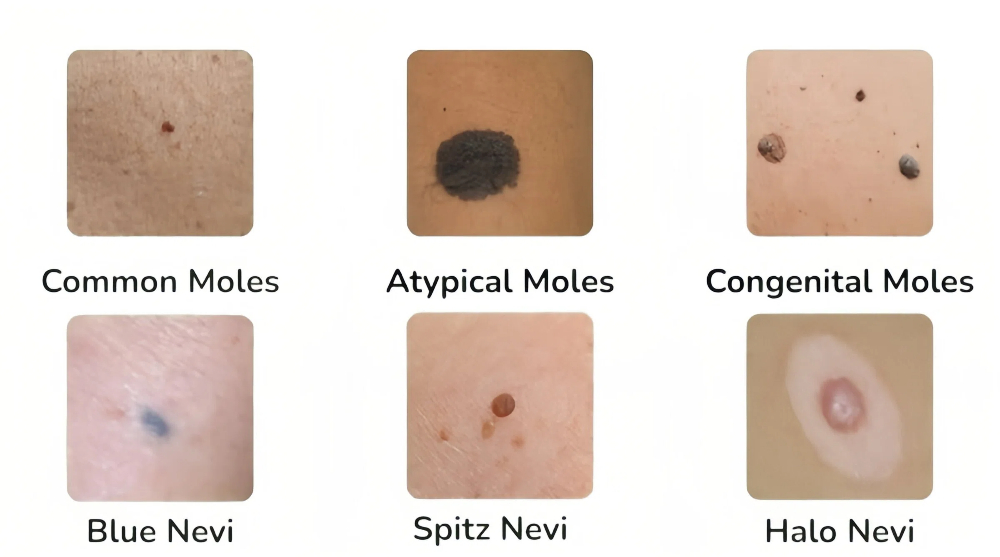Moles are frequent skin growths created by the clustering of melanocytes, which contain the melanin-producing cells that determine skin color. Moles start out as skin abrasions and eventually develop brown or black as a result of sun exposure. According to AAD (The American Academy of Dermatology), most people have between 10 and 40 moles on their bodies. Moles are usually harmless. In some cases, they might become malignant if not detected and removed.
Facial moles are common skin growths that can appear at any stage of life. While some people embrace them as beauty marks, others find them bothersome or want to get rid of them for cosmetic reasons. A mole on the face can sometimes affect self-confidence, interfere with shaving, or even cause discomfort when irritated by jewelry, clothing, or makeup.
Today, there are many medical treatments available for mole removal, such as laser, cryotherapy, or surgical excision. But for those who prefer a more natural, less invasive approach, home remedies are a popular choice. Natural remedies aim to lighten or shrink the mole gradually without harsh procedures.
It’s important to note, however, that not all moles are harmless. Some can be warning signs of skin cancer. Before trying any natural remedy, it’s always best to get your mole checked by a dermatologist. With that in mind, let’s explore how you can safely attempt to reduce or fade moles from your face naturally.
Different Types of Facial Moles

|
Mole Type |
Description / Appearance |
Risk Level |
Common Facial Locations |
|
Common Moles |
Small, round, and light to dark brown in color, usually less than 6 mm in diameter. |
Low |
Can appear anywhere on the face. |
|
Atypical Moles |
Larger than typical moles, often irregular in shape and uneven in color, generally over 6 mm in size. |
Moderate to High |
Commonly found on the nose and cheekbones. |
|
Congenital Moles |
Present from birth; tend to be large, irregularly shaped, and may range from 1.5 cm up to 20 cm. |
Moderate |
Often seen on the forehead or scalp. |
|
Blue Nevi |
Blue or bluish-black in color due to deeper pigment cells; usually small, round, and slightly raised. |
Low |
Appear mostly on the cheeks and scalp. |
|
Spitz Nevi |
Pink, red, or brown in color, sometimes resembling melanoma in appearance. |
Moderate |
Typically found on the cheeks, nose, or bridge of the nose. |
|
Halo Nevi |
Moles surrounded by a lighter, depigmented ring (halo) around them. |
Low |
Common near the temples and forehead. |
What Causes Moles to Appear on the Face?
If you’ve ever wondered why moles develop on your face, you’re not alone. Facial moles, like those on other parts of the body, can appear due to several factors ranging from genetics to environmental influences. Understanding these causes can help you better monitor your skin and maintain its health.
1. Genetics
Your genetic makeup plays a major role in determining how many moles you have and what types they are. If one or both of your parents have multiple moles, there’s a higher chance you’ll develop them too.
2. Sun Exposure
Ultraviolet (UV) radiation from sunlight is one of the most common triggers for mole formation. Overexposure to the sun can not only increase the number of moles but may also darken existing ones over time.
3. Hormonal Changes<
Hormone fluctuations during puberty, pregnancy, or menopause can stimulate new mole growth or cause changes in existing moles. These shifts are generally harmless but should still be observed.
4. Skin Type
Individuals with lighter or fair skin are more likely to develop moles because their skin is more sensitive to UV damage. Regular use of sunscreen can help reduce this risk.
5. Age
Moles often start appearing in early childhood and adolescence. New moles can continue to form until around the age of 40, after which existing moles may lighten, fade, or slightly change in appearance.
By understanding what causes moles on the face, you can take preventive steps such as sun protection and regular skin checks. In cities with strong sunlight and high UV exposure, consistent mole monitoring is especially important to prevent pigmentation issues and detect any abnormal changes early.
Precautions Before Trying Natural Remedies
Some natural methods may not only fail to work but can also pose potential risks. Before you begin, keep these important points in mind:
● Consult a dermatologist first. If your mole shows unusual changes, do not treat it at home.
● Many natural remedies are acidic or potent, which may irritate if you have sensitive skin. So, patch test the ingredients first.
● Avoid forceful removal because cutting, burning, or scratching a mole at home can cause infection and scarring.
● Natural methods work slowly and may not completely remove the mole, but can lighten it.
Natural Remedies for Mole Removal
Here are some of the most commonly used natural remedies for fading or shrinking moles on the face.
Apple Cider Vinegar (ACV)
Apple cider vinegar contains acetic acid, which may help dry out mole tissue over time.
How to use:
1. Soak a cotton ball in diluted ACV.
2. Place it on the mole and secure it with a bandage for about 30 minutes.
3. Rinse with water and repeat once a day.
Using undiluted ACV can lead to chemical burns, permanent scarring, or infection. Always dilute it properly and avoid prolonged contact with the skin.
Garlic Paste
Garlic is believed to contain natural enzymes that can break down the pigment in moles and help them fade gradually.
How to use:
1. Crush a fresh garlic clove to make a paste.
2. Apply it directly to the mole and cover with a bandage.
3. Leave overnight and wash off in the morning.
Garlic can irritate the skin or cause redness and a burning sensation. Apply a thin layer of petroleum jelly around the mole to protect nearby skin.
Castor Oil and Baking Soda
A mix of castor oil and baking soda is often used to help dry out moles while soothing the skin.
How to use:
1. Combine a few drops of castor oil with a small pinch of baking soda.
2. Apply the paste on the mole and cover it with a bandage overnight.
3. Repeat daily for several weeks.
This remedy is based on anecdotal evidence only. It may cause burns or scarring, and its effectiveness hasn’t been scientifically confirmed.
Aloe Vera Gel
Aloe vera has soothing and skin-healing properties that may help lighten mole pigmentation gently.
How to use:
1. Extract fresh aloe vera gel and apply it directly to the mole.
2. Leave it on for about 30 minutes, then rinse off.
3. Use twice daily for best results.
This is one of the safest and most skin-friendly natural approaches.
Tea Tree Oil
Tea tree oil is known for its antimicrobial and skin-lightening benefits, which may help reduce mole pigmentation.
How to use:
1. Dilute a few drops of tea tree oil with a carrier oil such as coconut oil.
2. Apply the mixture to the mole twice a day.
Always dilute tea tree oil, as undiluted use can cause irritation or dryness.
While these natural remedies are widely used, their effectiveness is not supported by scientific research. Results vary from person to person, and improper use may cause skin irritation or scarring. Always proceed with caution and consult a dermatologist if you’re uncertain.
Signs Your Mole Might Need Medical Attention
If a mole begins to change in color, size, or shape, it could be an early warning sign of skin cancer. Moles that start to itch, develop a red outline, or bleed should never be ignored and must be examined by a dermatologist. Your skin specialist can assess whether the mole is harmless or requires removal.
Dermatologists often follow the ABCDE rule to evaluate potentially risky moles:
● A – Asymmetry: One half of the mole doesn’t match the other.
● B – Border: Edges appear uneven, blurred, or irregular.
● C – Color: Contains multiple shades or uneven pigmentation.
● D – Diameter: Larger than about 6 mm (roughly the size of a pencil eraser).
● E – Evolving: Shows noticeable changes in shape, size, color, or symptoms over time.
Professional Methods for Mole Removal
1. Surgical Excision or Shaving
A dermatologist uses a sterile scalpel to carefully remove the mole. The treated area is then cauterized or covered with an antibiotic ointment to control bleeding and reduce the risk of infection.
2. Full Excision
This method is preferred for flat or deeper moles. After sterilizing and numbing the area, the mole and a small portion of surrounding skin are cut out with a scalpel, and the wound is closed with stitches for proper healing.
3. Cryotherapy (Freezing)
Liquid nitrogen is applied to the mole using a spray or cotton swab. The intense cold forms a blister, causing the mole tissue to die and eventually fall off as the skin heals.
4. Electrocautery
This technique removes the mole using controlled electric current, which burns and destroys the mole tissue with minimal bleeding.
5. Laser Removal
A quick and relatively painless procedure that targets mole pigment using concentrated light energy, effectively breaking down and removing the mole tissue without cutting the skin.
Takeaway
There’s currently no scientific evidence that natural or home remedies can completely remove moles. Most substances believed to “dry out” or “fade” mole tissue actually irritate or damage the skin’s surface without affecting the underlying melanocyte cells that cause moles to form. This can lead to scarring, infection, or delayed diagnosis of skin cancer if the mole is malignant.
If mole removal is desired, it should always be done under medical supervision. Dermatologists can safely evaluate the mole using dermatoscopy and remove it through evidence-based procedures such as laser therapy, cryotherapy, or surgical excision. Regular skin checks and consistent sun protection remain the most effective ways to maintain healthy, mole-free skin.


